

SUUNTOブログ
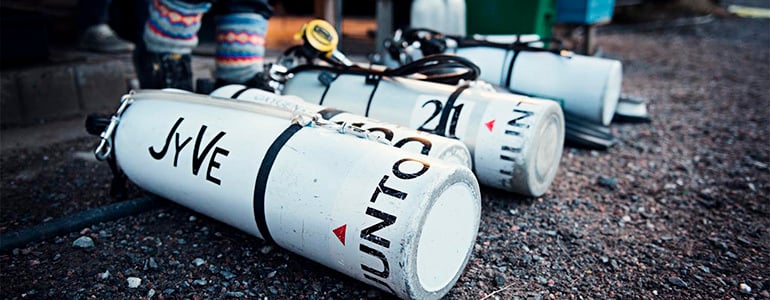
Why tech divers need to know about micro bubbles
Tech diving means going deeper for longer and requires, as the name suggests, a more technical understanding of what's going on with your gases. In this second part on Suunto algorithms, we go deeper into Suunto's RGBM. For technical divers, there are two key reasons Suunto’s Reduced Gradient Bubble Model, or RGBM, algorithm stands out. The first is microbubbles. No other brand of dive computer takes into account the accumulation of inert gases on this level. At any given point, even when you’re on dry land, your veins and arteries have microbubbles filled with these inert gases. When small, they’re of no consequence.
But when they expand from time at depth, they begin to limit off-gassing. The deeper you dive, the greater a risk factor microbubbles potentially become. Suunto’s computers will force you to decrease your ascent rate when microbubbles start to become an issue.
Second, Suunto is the only brand whose computers factor in the risk of isobaric counterdiffusion (ICD), which can potentially occur on ascent. Normally, as you breathe while making your way back to the surface, you’re off-gassing; however, depending on your gas blend, these inert gases could travel further into your system as opposed to out, due to the increasing partial pressures of gases upon ascent. Suunto’s computers will alert you when you’re at risk of ICD, and will alter your ascent plan as necessary to keep you safe.
How does ICD affect divers? Hear Dr Wienke explain below and check out our other video guides to our algorithms here.
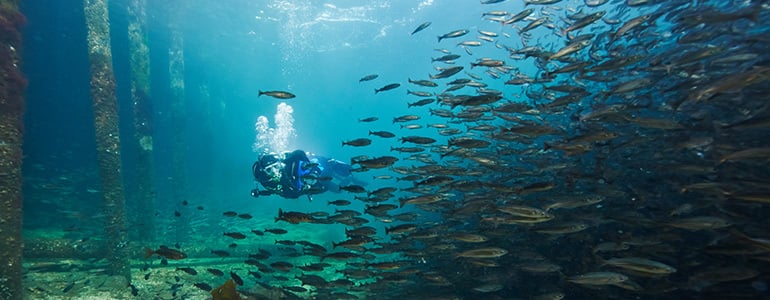
Computer Algorithms Explained
Knowledge is power – and having an understanding of what's going on inside your dive computer will help you dive more safely and with peace of mind. Here's what you need to know on Suunto's algorithm that keeps you safe: Think of dive algorithms as you do the Internet: Few of us can actually explain how email works, but we all agree that life is infinitely better with it. The algorithms powering your dive computer are much the same: You need only appreciate how you benefit. Algorithms are ever-adapting formulas that constantly measure how much nitrogen is accumulating in your body as you remain underwater.
© Janne Suhonen
When you first started diving, relying on the tables was fine because, most likely, your air consumption wasn’t efficient for you to stay down long enough to complicate things. Then, at some point, you noticed everyone with a dive computer was enjoying longer dives. They could duck down a few meters to swim nearer a shark or turtle, and this didn’t significantly shorten that dive or subsequent dives. Simply put, they were carefree. They knew their computers were factoring in these depth changes to keep them safe.
When we dive, inert gases—such as nitrogen, which our body doesn’t need—are dissolving into the bloodstream. At any given point, even when you’re on dry land, your veins and arteries have microbubbles filled with these inert gases. When small, they’re of no consequence. But when they expand, say, from time at depth, they begin to limit off-gassing—that is, your body’s ability to expel nitrogen.Only Suunto factors microbubbles into their algorithms. The deeper you dive, the greater a risk factor they potentially become. Their dive computers will force you to decrease your ascent rate when microbubbles are starting to become an issue.
Suunto’s Reduced Gradient Bubble Model, or RGBM, is the industry’s most accurate representation of what’s happening in your body when you dive. It automatically adjusts to what you’re doing underwater. After you’ve told it you are diving air or a particular Nitrox blend, it requires no further manual input, leaving you free to enjoy your dive.
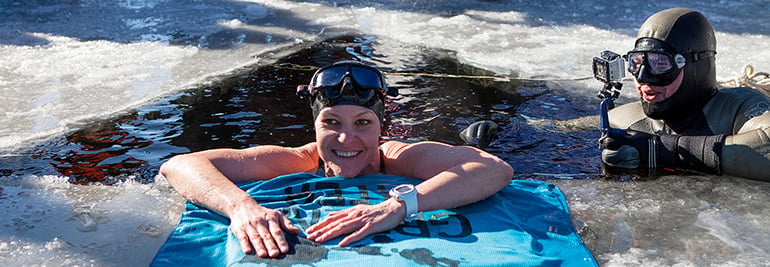
Johanna Nordblad’s 50-meter swim under ice
Finnish freediver Johanna Nordblad made a Guinness World Record Attempt last Saturday at Lake Päijänne in Finland when she swam 50 meters under ice.
The dive team and spectators gathered on the ice on a beautiful sunny day for the record attempt.
The water temperature was 2 degrees Celcius when Johanna swam a distance of 50 meters under the ice from one hole to another. Everything went according to the plan. Nordblad said the dive was easy and that she couldn't be happier.
Nordblad is an experienced freediver who has been competing at the World Championships since 2000. In 2004 she did a World Record in Dynamic with fins, 158 meters. In 2013 in Serbia she swam 192 meters and was on the 7th place.
Cold-water training has been a big part of Johanna Nordblad's training since she broke her leg in downhill mountain biking. Cold water helped in rehabilitation and soon became a big part of her wintertime training in Finland.
Johanna Nordblad is the first woman to swim 50 meters horizontally under ice with no fins and no diving suit. The men's record is held by Stig Severinsen, who dove 76,2 meters under ice in 2013.
Watch a video of Johanna’s dive (part 1).
Learn more about Johanna Nordblad’s dive here
Images: © Elina Manninen
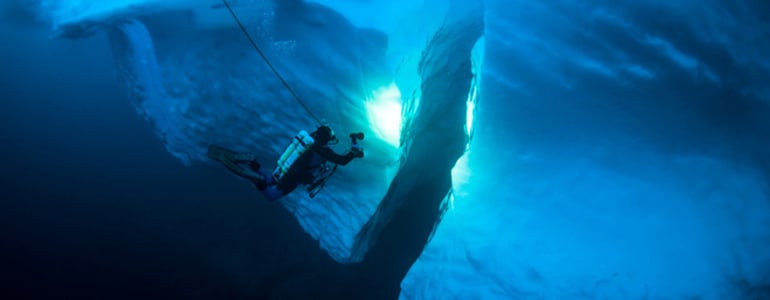
Sea ice at last for the Under the Pole team
The latest update has come in from Greenland, with the Under the Pole team talking diving holes, science and inviting locals to join in on the experience.Under the ice © Lucas Santucci / Under The PoleMuch jubilation was felt amongst the team as after months of waiting they finally have sea ice surrounding them.“The ice is moving, cracking and grinding, northern lights are dancing at night around the Why [the name of their boat] and the dives are splendid, offering visibility down to 60 and 70 meters,” writes expedition leader, Grislain Bardout in his latest newsletter. “Having the boat icebound was a dream. How beautiful she is!”Life is not easy for the crew, however, who work in temperatures falling to -30 degrees C. With ice anything up to 60 cm thick it also freezes the toilet pipes meaning these must be defrosted before every day can begin.Pricila, the chef on the boat gets ready to dive for the first time © Lucas Santucci / Under The PoleThey are making headway on their scientific work, however, Ghislain says: “Science wise, we started the cryosphere program, or interaction between atmosphere, ice and ocean. Part of the boat was transformed into an efficient laboratory. This program is extremely interesting because it provides us with a real database on our environment during the ice season.”There was also a bit of fun to be had at the weekend during a visit to Ikerasak with the diving equipment to allow inhabitants to discover the undersea world. “All together we shared this event and, in spite of our languages and cultural differences, the diving hole was surrounded all day long by thirty persons or more. Twelve of them dared to immerse and went to see under the ice, although they didn’t even know how to swim,” adds Ghislain.The team also plans to invite hunters and children from the Uummannaq Home to join them on the ice.Main image: © Lucas Santucci / Under The Pole
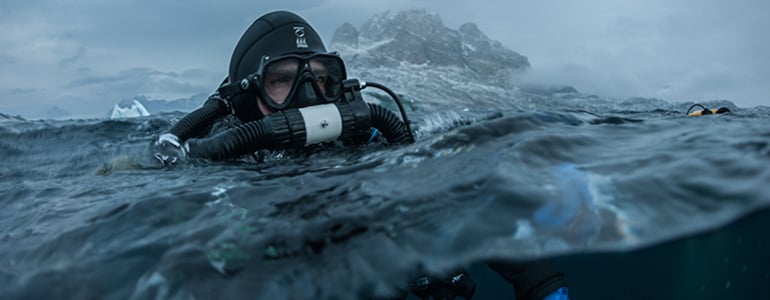
Surviving Northern Nights Under the Pole
As the Under the Pole team journey up Greenland’s coast they battle through howling storms and fast-freezing seas, but it’s all worth it for the spectacular scenes above and below the ice. Click the video below to see for yourself:
Winter has truly visited Greenland, where a group of French explorers and scientists have been sailing up the west coast. After battling through a 14 hour storm – complete with mini icebergs bashing against the side of the boat – and spending New Year in the harbor town of Uummannaq, the team continue up the coast until the ice becomes too thick to sail any further.
After two days of waiting, the sea around their boat freezes enough to walk and sled across, much to the joy of Kayak, the team’s Siberian husky. But the real reward comes after dark, when the team are able to dive under the ice itself, and get to witness the northern lights flickering behind the WHY (the team’s yacht). “We’ve only just started to explore but still we had so much fun,” says Ghislain Bardout, expedition chief. “Then to come out and see the northern lights and the “WHY”, I think is as nice as the dive itself.”
The Under The Pole team has also released an educational video on the northern lights (Aurora Borealis), which you can view here.
Turns out it’s not caused by the spirits of the dead playing soccer with a walrus skull…
Main image: © Lucas Santucci / Under The Pole
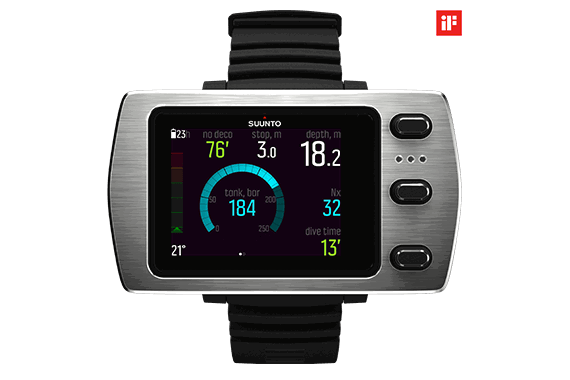
Suunto EON Steel wins prestigious award
Suunto’s next generation dive computer receives global iF Design Award 2015
Suunto is pleased to announce that Suunto EON Steel, the fully customizable dive computer, has been awarded the iF Design Award 2015 in the Product category. This award is an important recognition of the Finnish company's success in developing diving innovations in the last 50 years.
Handmade in Finland, Suunto EON Steel combines advanced technology with a bright color screen and customizability to let you choose exactly what you want to see on your dive. The easy-to-use dive computer was developed in close relationship with active divers around the world. It has been extensively tested including dives in the caves of an old limestone mine in Ojamo, Finland. Creating reliable products designed for the harshest of elements has been a part of Suunto’s heritage for almost 80 years.
Comments Björn Bornemann, the Designer of Suunto EON Steel: “We’re thrilled to receive this prestigious award which is a fitting tribute to the hard work of the whole product team. With heavy-duty housing, a stainless steel bezel, and user updatable software, Suunto EON Steel is built to last.”
The iF Product Design Award was introduced in 1954 and is a highly prized seal of quality annually conferred by the International Forum. Every year the iF attracts more than 2,000 product entries from around 37 nations, which are judged by renowned experts. www.ifdesign.de














































































